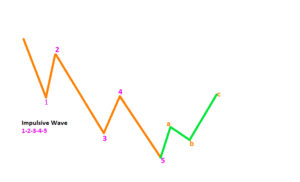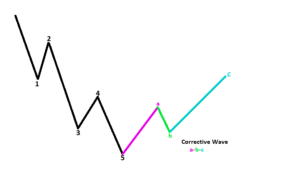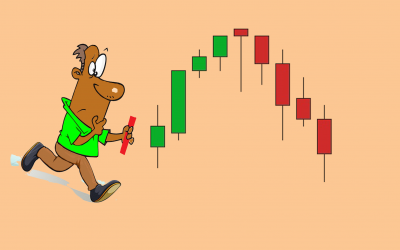Elliot Wave Theory Summary is an overview of all details of Elliot Wave Theory covered in our previous lessons.
Elliot wave theory was founded by a business expert accountant trader, Mr. Ralph Nelson Elliot.
From his analysis on the stock market, Elliot concluded that the market is not rational.
The continuous change in stock market prices is due to the basic harmony found in nature.
Elliot explains these happenings that people rarely change their behavior. Therefore trends and reverse patterns occur in a repetitive form on the charts relating to people’s behavior.
He then further, illustrated these patterns and named them waves.
Elliot believed that since the same things always happen in the market, traders can identify these patterns in the trending market price charts and tell where price will go next.
Elliot Wave theory summary
Under his theory, Elliot put the following facts.
The market participants bring power struggles in the market. As the market progresses, these power struggles sometimes make it divert from its direction.
He therefore looked at this kind of behavior appears into two different forms on a market chart;
That is;
- The impulsive move
- The corrective move.
Impulsive Wave

The impulsive waves can occur both in an uptrend and down trend. Impulse elliot wave theory summary;
It takes a form of 5-3 wave patterns.
It has the three waves 1, 3, 5 moving in the direction of the trend, the motive waves and two waves 2 and 4 which move against the trend.
Waves 1, 3, 5 can further be divided into five smaller waves each while 2 and 4 into 3’s.
Wave 2 can never go beyond wave one and wave 4 can never retrace into wave 1.
Corrective Wave
The corrective wave comprises of 3 waves moving in the opposite direction of the initial trend. Corrective patterns elliot wave theory summary;
This wave pattern can never move beyond the origin of the previous impulse wave.
The letters a, b, c are used to label these waves respectively.

In addition,the corrective waves may appear inform of zigzag, flat, triangles or a combination.
The zigzag correction is a 3 wave correction labeled A-B-C. It takes a form of 5-3-5. A and C are motive waves with 5 sub waves while b is corrective with 3 sub waves.
The flat correction is a sideways 3 wave correction where the sub waves appear inform of 3-3-5.
It is labeled A-B-C. A and B is corrective with 3 sub waves and C is a motive wave with 5 sub waves. The fourth wave in an impulse waves often has it.
The triangles are overlapping 5 wave patterns, A-B-C-D-E.
Therefore, It takes a form of 3-3-3-3-3.
It Moves in a sideways movement with decreasing volumes and volatility.
Combinations (double and triple).
This is the sideways combinations of the corrective pattern; double 3s and triple 3s.
It is combination of the zigzag, flat and triangles making a flat correction extending sideways.
Thus, Double 3s and triple 3s are horizontal in character.
The 3 main Elliot wave rules trading Elliot wave.
- Wave 2 never retraces 100% of wave 1
- Elliot Wave 3 is never the shortest wave in a completed 5 wave sequence.
- Wave 4 cannot retrace into wave 1
Guidelines
- The impulse wave comprises of 5 waves.
- Wave 3 is usually the strongest wave
- Elliot Wave 5 and wave 1 are very often equal in price
- Wave 2 usually unfolds as simple a-b-c correction
- Once a 5-wave sequence is complete, the corrective wave begins.
- The first leg off the move from the 5 impulse wave pattern often finds support and resistance at the prior minor wave 4.
- When the corrective pattern completes, the main trend resumes
- Wave 4 can’t retrace into the area of Wave 1.
The violation of any of the above rules implies that the Elliot wave count is incorrect.
Avaricious Life of a Newbie Trader.
Life of a Newbie Trader in Forex is super Interesting. With a lot of eager to make money, you never want to miss out on any chance. When you read about Forex trading, everything is simple. You may even start to think that your friends may not recognize you after...
- Oh, bother! No topics were found here.



